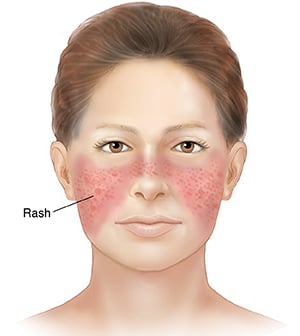Lupus is a condition that confuses many people because it can show up in different ways. One common form is called Cutaneous Lupus Erythematosus (CLE), which mainly affects the skin. While it may not sound as serious as other types of lupus, it can still cause discomfort, emotional stress, and visible skin changes. Understanding CLE can help people recognize the symptoms early and manage the condition better.
What Is Cutaneous Lupus?
Cutaneous lupus is a type of autoimmune disease. In autoimmune diseases, the immune system, which normally protects the body from infections, begins to attack healthy tissues instead. In the case of CLE, the target is the skin. This leads to rashes, lesions, and other skin problems that often get worse with sunlight (Uva et al., 2021).
There are different forms of cutaneous lupus, and they vary in severity:
- Acute Cutaneous Lupus (ACLE): This form is often seen in people who also have systemic lupus. It usually appears as a red rash over the cheeks and nose, forming a “butterfly” shape. The rash may come and go and is often triggered by sunlight (Bally et al., 2020).
- Subacute Cutaneous Lupus (SCLE): This causes red, scaly, ring-shaped or patch-like rashes on sun-exposed areas like the chest, arms, and back. It doesn’t usually leave scars, but it may cause discoloration (Ferreira et al., 2022).
- Chronic Cutaneous Lupus (CCLE), also known as Discoid Lupus: This is the most severe type of CLE. It creates thick, scaly, disk-shaped sores that can leave scars and even cause permanent hair loss if they appear on the scalp (Patel et al., 2019).
What Causes Cutaneous Lupus?
The exact cause of CLE is not fully known, but it’s believed to be a combination of genetic, environmental, and hormonal factors. Some people may be more likely to get it if lupus runs in their family. Exposure to sunlight, stress, infections, and certain medications can also trigger symptoms. CLE is more common in women and usually appears between the ages of 20 and 50 (Uva et al., 2021).
Symptoms to Look Out For
People with CLE usually notice:
- Red or purple rashes that may be painful or itchy
- Skin lesions that worsen with sunlight
- Scarring or dark spots after the rash heals
- Hair thinning or loss (if the scalp is affected)
- Sores inside the mouth or nose (less common)
These symptoms can sometimes appear without any other health problems, or they might be part of Systemic Lupus Erythematosus (SLE), which affects other organs like the kidneys and heart.
How Is It Diagnosed?
To diagnose CLE, a doctor will usually start with a physical exam and ask questions about the person’s symptoms and medical history. A skin biopsy, where a small piece of skin is removed and tested, can help confirm the diagnosis. Blood tests may also be done to check for autoantibodies, which are often found in people with lupus (Ferreira et al., 2022).
Treatment Options
While there is no cure for CLE, it can be managed with treatment. The main goals are to reduce inflammation, prevent flares, and protect the skin. Some common treatments include:
- Sun protection: This is the most important step. Wearing sunscreen (SPF 50+), wide-brimmed hats, and long sleeves can help prevent flare-ups.
- Topical creams: Corticosteroids or calcineurin inhibitors can help calm inflamed skin.
- Oral medications: Drugs like hydroxychloroquine (used to treat malaria) can be very helpful for controlling skin symptoms and are commonly used for CLE (Patel et al., 2019).
- Lifestyle changes: Avoiding smoking, managing stress, and eating a balanced diet may also help improve symptoms.
In more serious cases, doctors may prescribe immunosuppressants, which help to calm the overactive immune system.
Living with Cutaneous Lupus
Living with CLE can be challenging, especially since the symptoms are visible and may affect self-esteem. Some people feel embarrassed or anxious about their appearance, especially during flare-ups. Mental health support, such as counseling or support groups, can be very helpful. It’s also important to keep up with regular doctor visits, follow the treatment plan, and be patient managing CLE takes time and effort.
Cutaneous lupus may not affect internal organs like systemic lupus does, but it still requires care and attention. With the right diagnosis, sun protection, and medical support, many people with CLE can manage their symptoms and lead full, active lives. Early treatment can also reduce the risk of long-term skin damage and improve quality of life.
References
- Bally, A. P., Gommerman, J. L., & Gill, P. A. (2020). The role of environmental triggers in lupus pathogenesis. Frontiers in Immunology, 11, 614101. https://doi.org/10.3389/fimmu.2020.614101
- Ferreira, C., Costa, M. A., & Pinto, D. C. (2022). Cutaneous lupus erythematosus: Pathophysiology and new treatment approaches. Journal of Dermatological Science, 108(2), 79-88. https://doi.org/10.1016/j.jdermsci.2022.02.001
- Patel, N. J., Sinha, A. A., & Werth, V. P. (2019). Update on the pathogenesis and treatment of cutaneous lupus erythematosus. Current Opinion in Rheumatology, 31(6), 642-648. https://doi.org/10.1097/BOR.0000000000000654
- Uva, L., Miguel, D., Pinheiro, C., Freitas, J. P., Marques Gomes, M., & Filipe, P. (2021). Cutaneous manifestations of systemic lupus erythematosus. Autoimmune Diseases, 2021, Article ID 4719801. https://doi.org/10.1155/2021/4719801











